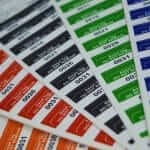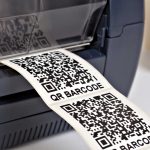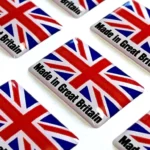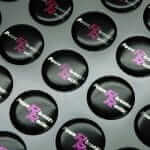The different label types and which should you choose?
At Customark, we offer many different types of labels, stickers and adhesive products. The use case for each labels differs between its application. To help you make your decision, we've made a handy guide to distinquish between the variety of label types and when's best to use them and which type to choose.
Roll Labels
What are Roll Labels?
These are labels wound on a core or roll, ideal for high-volume, automated application processes. They’re commonly used in industries like food & beverage, pharmaceuticals, and logistics.
Benefits of using Roll Labels:
- Efficient for mass production.
- Customisable sizes, shapes and materials.
- Work well with automated labelling machines.
- Versatile—compatible with a wide variety of surfaces.
What to avoid when choosing Roll Labels:
- Choosing a material that doesn’t fit the product environment (e.g., using paper labels for products exposed to moisture).
- Misaligning rolls with application machinery can lead to wasted labels.
- Not considering the correct adhesive strength.
History of Roll Labels:
Roll labels grew popular in the mid-20th century as businesses scaled up production. The development of self-adhesive materials played a pivotal role in their evolution.
Interested in learning more about Roll Labels? To see our range of options, click here.
Packaging Labels
What are Packaging Labels?
These are labels directly applied to packaging (boxes, wraps, bottles), often serving as both branding and compliance tools.
Benefits of using Packaging Labels:
- High potential for creativity and brand impact.
- Essential for communicating regulatory information.
- Can be integrated with eco-friendly materials for sustainable branding.
- Custom finishes (e.g., embossing, foil stamping) offer premium feel.
What to avoid when choosing Packaging Labels:
- Overloading labels with too much information or design elements, reducing readability.
- Skimping on durability for packaging that will face heavy handling.
- Not adhering to industry-specific regulations (e.g., nutrition labels for food products).
History of Packaging Labels:
Packaging labels date back to early trade, where merchants would mark goods for identification. The industrial revolution saw a boom in mass-produced packaging, driving the need for uniform labelling.
Interested in learning more about Packaging Labels? To see our range of options, click here.
Digital Labels
What are Digital Labels?
These are labels that use high-tech printers to produce small to medium runs of labels quickly. Often used for short-run, customised, or personalised labels.
Benefits of using Digital Labels:
- Quick turnaround time.
- Cost-effective for short runs compared to traditional printing.
- High level of customisation and detail, great for variable data (e.g., barcodes, unique serial numbers).
- Environmentally friendly—less waste compared to analogue printing methods.
What to avoid when choosing Digital Labels:
- Using digital labels for very high-volume runs where analogue methods might be more cost-effective.
- Not factoring in the limitations on certain material types.
- Overlooking the colour consistency challenges with certain substrates.
History of Digital Labels:
Digital label printing has roots in the early 1990's but became mainstream with advances in printing technologies. The ability to produce on-demand, short-run labels revolutionised industries that required rapid, customised solutions.
Interested in learning more about Digital Labels? To see our range of options, click here.
Eco-Friendly Labels
What are Eco-Friendly Labels?
These are labels made from sustainable materials, often designed to be biodegradable, recyclable, or produced from renewable resources.
Benefits of using Eco-Friendly Labels:
- Aligns with growing consumer demand for environmentally friendly products.
- Biodegradable options reduce environmental impact.
- Available in a variety of materials like recycled paper, water-based adhesives, or soy-based inks.
What to avoid when choosing Eco-Friendly Labels:
- Not checking material compatibility with your product (e.g., some eco-friendly labels may not handle moisture well).
- Over-promising environmental benefits (green-washing).
- Skipping certification from credible eco-labeling bodies.
History of Eco-Friendly Labels:
The rise of eco-labeling gained momentum in the 1990's with increased environmental awareness, alongside the development of sustainable materials for packaging.
Interested in learning more about Eco-Friendly Labels? To see our range of options, click here.
Component Test Labels
What are Component Test Labels?
These are labels used for marking components that need to be tested or have passed specific quality control checks.
Benefits of using Component Test Labels:
- Can include specific data like serial numbers, test results, or compliance information.
- Often made with durable, tamper-evident materials.
- Can be customised for different testing needs, including barcodes, QR codes, or RFID tags.
What to avoid when choosing Component Test Labels:
- Using labels that are not durable enough to last through the testing process (e.g., heat, friction, moisture).
- Failing to meet industry standards for compliance tracking.
History of Component Test Labels:
As manufacturing became more regulated and complex in the mid-20th century, the need for reliable testing labels grew, particularly in sectors like automotive, aerospace, and electronics.
Interested in learning more about Component Test Labels? To see our range of options, click here.
Asset Labels
What are Asset Labels?
These are labels designed for asset tracking and management, often featuring barcodes or serial numbers.
Benefits of using Asset Labels:
- Helps in maintaining an organised asset management system.
- Can be tamper-evident or durable enough for outdoor use.
- Easily integrates with asset tracking software for better control and audits.
What to avoid when choosing Asset Labels:
- Not choosing the right material for the environment (e.g., outdoor vs. indoor assets).
- Failing to make labels tamper-proof for high-value assets.
History of Asset Labels:
Asset labels became vital with the rise of computerised inventory systems in the late 20th century, making it easier to monitor and manage assets on a large scale.
Interested in learning more about Asset Labels? To see our range of options, click here.
Barcode Labels
What are Barcode Labels?
These are labels featuring barcodes for product identification, inventory management, or pricing.
Benefits of using Barcode Labels:
- Fast and accurate scanning in retail and logistics.
- Simple and cost-effective solution for large-scale inventory management.
- Can be customised with variable data for unique identifiers.
What to avoid when choosing Barcode Labels:
- Poor print quality that renders barcodes unreadable by scanners.
- Using materials incompatible with the barcode printing technology.
- Not aligning label size with barcode scanner specifications.
History of Barcode Labels:
The first commercial use of barcodes was in the 1970's in grocery stores, revolutionising retail with faster checkout systems and better stock control.
Interested in learning more about Barcode Labels? To see our range of options, click here.
Parking Permit Stickers
What are Parking Permit Stickers?
These are stickers issued for parking permissions, often for specific locations or time frames.
Benefits of using Parking Permit Stickers:
- Can be designed with tamper-evident features to prevent misuse.
- UV-resistant and durable materials ensure long-lasting readability.
- Easy to apply and remove without damaging surfaces like car windows.
What to avoid when choosing Parking Permit Stickers:
- Using adhesives that leave residue or are too difficult to remove.
- Designing permits that fade quickly under sun exposure.
- Forgetting to include security features like holograms for added authenticity.
History of Parking Permit Stickers:
Parking permits grew in use in the 20th century as cities and businesses sought ways to regulate parking in restricted areas.
Interested in learning more about Parking Permit Stickers? To see our range of options, click here.
Resin Domed Labels
What are Resin Domed Labels?
These are labels coated with a clear, thick layer of polyurethane resin, creating a raised, 3D effect.
Benefits of using Resin Domed Labels:
- Highly durable, resistant to scratching, UV rays, and weather.
- Great for long-lasting applications like on machinery, vehicles, or electronics.
- Provides a premium look and feel for brand labels.
What to avoid when choosing Resin Domed Labels:
- Using the resin on flexible surfaces where it may peel or crack.
- Not considering the additional cost of resin coating for large quantities.
- Avoiding surfaces that can’t support the weight or texture of the label.
History of Resin Domed Labels:
Resin domed labels became popular in the 1980's for their aesthetic appeal and durability, especially in the automotive and consumer electronics sectors.
Interested in learning more about Resin Domed Labels? To see our range of options, click here.
Nameplate Labels
What are Nameplate Labels?
These are metal and plastic Nameplates used to display names, titles, or product details, often in industrial or corporate settings.
Benefits of using Nameplate Labels:
- Extremely durable, especially when made from metals like aluminium or stainless steel.
- Resistant to harsh conditions such as heat, chemicals, and abrasion.
- Customisable with etching, engraving, or embossing for premium appearance.
What to avoid when choosing Nameplate labels:
- Choosing material or finishes that don’t match the intended environment (e.g., using untreated metal in corrosive environments).
- Over complicating the design, making it difficult to read at a distance.
- Failing to comply with regulatory specifications, particularly in industrial use cases.
History of Nameplate Labels:
Nameplates have been in use for centuries, particularly for identification on machinery or official documents, with early versions often made of engraved wood or brass.
Interested in learning more about Nameplates? To see our range of options, click here.
Gaskets & Insulators
What are Gaskets & Insulators?
These are custom-cut materials used in sealing applications, often in industrial and electronic contexts.
Benefits of using Gaskets & Insulators:
- Provide critical sealing and insulation functions in various mechanical and electronic devices.
- Made from materials like rubber, foam, or silicone for high resistance to extreme temperatures and pressure.
- Can be die-cut to exact specifications for a precise fit.
What to avoid when choosing Gaskets & Insulators:
- Using materials that degrade too quickly under specific conditions (e.g., using rubber gaskets for high-heat environments).
- Incorrect sizing, leading to seal failure and potential equipment damage.
- Not considering the material’s chemical compatibility with surrounding components.
History of Gaskets & Insulators:
Gaskets and insulators have been used since the industrial revolution, becoming more specialised as industries like automotive, aerospace, and electronics advanced.
Interested in learning more about Gaskets & Insulators? To see our range of options, click here.
Safety Warning Labels
What are Safety Warning Labels?
These are labels used to communicate hazards or safety instructions, often required by law in various industries.
Benefits of using Safety Warning Labels:
- They ensure compliance with safety regulations.
- The use of bold colours and symbols increases visibility and awareness.
- Can be designed for specific environments, such as heat-resistant, glow-in-the-dark, or chemical-resistant materials.
What to avoid when choosing Safety Warning Labels:
- Over complicating the design, which can reduce the label’s effectiveness in an emergency.
- Failing to meet regulatory guidelines for size, colour, and wording (e.g., OSHA or ISO standards).
- Using materials that wear out or fade too quickly, reducing legibility.
History of Safety Warning Labels:
Safety labels have been in use since the early 20th century, particularly in industrial settings, with the introduction of standards like OSHA in the U.S. formalising their use.
Interested in learning more about Safety Warning Labels? To see our range of options, click here.



































